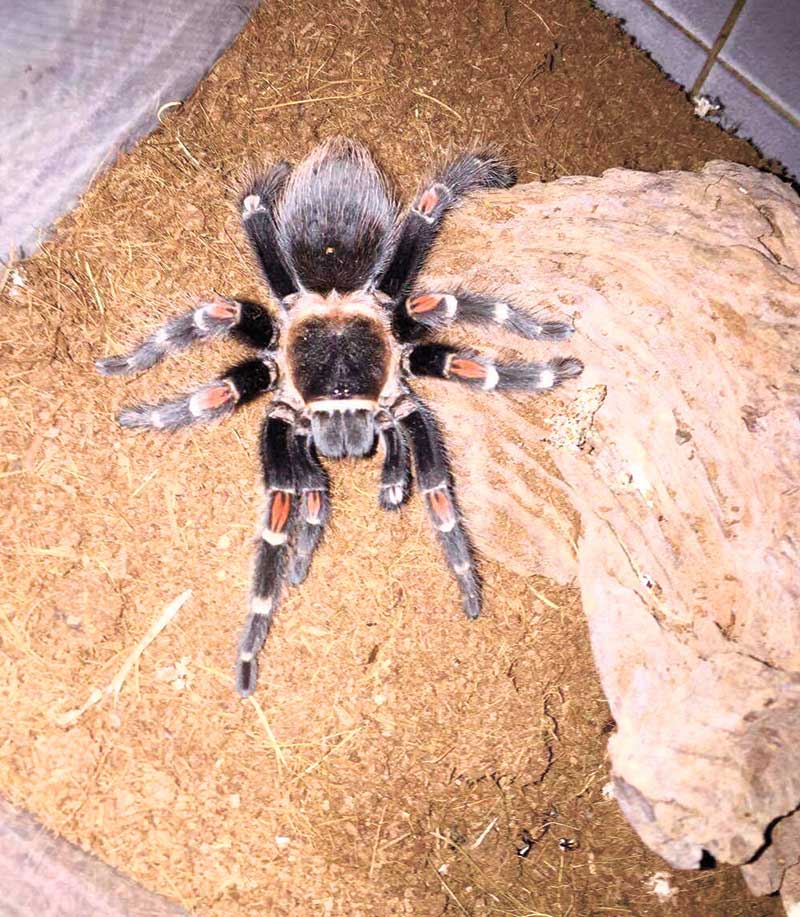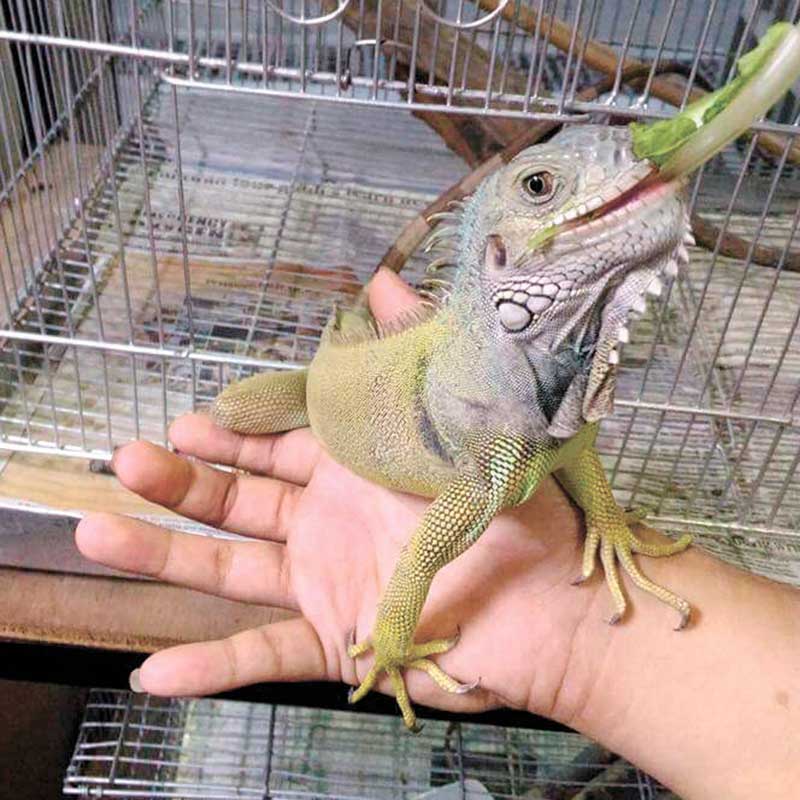Creepy crawly besties
Text: Mary Joyce Villaflor and Martie de Castro
STC Mass Comm Interns
SOME things in life are more than what meets the eye. For these pet owners, exotic animals bring a whole array of beauty and happiness beyond the physical perspective that most people have for these creatures.
SunStar Weekend talked to some of Cebu’s exotic animal owners on their tips on taking care of these “not-so-creepy” crawlies.
Jonathan Alcaraz, 21
Seafarer
A 21-year-old seafarer started raising a tarantula when his good friend gave it to him as a graduation present. He chose to raise it because he finds it cool to have a large spider as a pet, yet he doesn’t plan on raising more. He feeds his pet tarantula with any live insect he finds, but mostly just cockroaches since it’s abundant.

In raising tarantulas, he says that shelter depends on what type of tarantula you have. He bought his tarantula an acrylic cage from a local pet shop, placed driftwood and soil or moss as well as a small saucer with water. This is to set the temperature of the cage and keep the humidity controlled. He admits he is not that well-versed about the dos and don’ts for tarantulas yet, but he says he never forget to place water in the cage as it sets the temperature of the cage. It’s important to remember that tarantulas are really sensitive to temperature. Do not over feed your tarantulas as well.
“Owning a tarantula is unique in itself and getting to see them molt into bigger sizes feels much like an accomplishment to me.”
Emil Cuizon, 17
Student, taekwando coach
Passionate about sports and animals, Emil raises scorpions and snakes. He started raising scorpions when he was in the sixth grade and he started raising snakes when he was in the ninth grade. He has always been interested in arachnids, which is why he chose to raise scorpions and he is also planning to pursue a career in herpetology, which is why he chose to raise snakes as well.

In raising scorpions, he says to feed them pinky mice, roaches, superworms, crickets, vivarium, and do handle them with care. Always buy from a reputable breeder and only buy captive bred. Don’t catch or buy endemic animals as well. In raising so, do get permits. “Don’t be stingy when it comes to your pets. Do make sure you know what you’re getting yourself into.”
He says scorpions are uncommon pets and great conversation starters. They are entertaining to watch when they’re being fed and each has its own unique personality. Above all, they are easy to care for. Same thing goes for his tips in raising snakes. The only difference is that snakes are fed with rats or mice and vivarium. For the characteristics of snakes, he says they are easy to hold and easy to care for.
Katrena Cortes, 20
Mass Communication Graduate
Who says only boys own exotic animals? Katrena Cortes is a certified pet lover, who owns three rabbits, three new kittens, two turtles, eight dogs with one puppy, and tarantulas.
Katrena started collecting tarantulas last November 2016. She has a total of three tarantulas. She chose to raise them because she finds them cute, slow moving, cheap, and tamable.
Her pets’ names are Sky, Stuart, and Red. Their breeds are fireleg, vagan and albopilosum. She usually brushes their feet softly in the back with a small soft brush to make them aware of her presence. “They usually dig and hide under their coco peat and sometimes when I pet them they prefer to just stay in my palm without moving,” she said.
Most of the time she feeds them with laterals but sometimes with crickets and superworm. She shelters them in a plastic container with air holes on the cover with moist coco peat to hydrate them.
“Some Tarantulas are not safe since some of them are aggressive and mostly are venomous,” she warns. “Never disturb or agitate them specially when they are hungry and currently molting.”
Niño Earl Capacite, 20
Veterinary Student
Niño is interested in nature appreciation and as well as taking care of dogs and exotic animals. One of his plans in life is also to have a successful livestock business. He started raising exotic animals since he was in third grade, yet he already had domestic animals since he was young.
 He owns different types of animal species such as tarantulas, snapping turtles, scorpions, pacman frogs, fishes, rabbits, sugar gliders, leopard geckos, snakes, and dogs. He also has a nature aquarium with live plants, shrimps and fishes. He chooses to raise these kinds of animals because they are unusual and because of their uniqueness. You do not see them anywhere, and their colors and the way they adapt to the environment is attractive.
He owns different types of animal species such as tarantulas, snapping turtles, scorpions, pacman frogs, fishes, rabbits, sugar gliders, leopard geckos, snakes, and dogs. He also has a nature aquarium with live plants, shrimps and fishes. He chooses to raise these kinds of animals because they are unusual and because of their uniqueness. You do not see them anywhere, and their colors and the way they adapt to the environment is attractive.
On his tips in raising these kinds of animals, he says you should do your research before having one. Make sure you are able to provide for their needs as well. Feed them when they are hungry but do not overfeed them since it could cause abnormalities to their body or even death. Provide them with proper shelters and make sure they have individual closures.
“Each of them has their own characteristics actually. My tarantula, fishes, geckos and snakes display beautiful colors. My pacman frog could swallow its prey as big as their body, my scorpion has the ability to kill its prey with its venomous sting, the gliding abilities of my sugar gliders and most of all, the loyalty of my dogs.” He says all of them are his stress relievers and by merely just staring at them relaxes him. “Please do love your pet and know your pet. Give them welfare.”
Allan John Shaquel Suson, 23
Sales Representative
Allan is passionate about caring for his pets. He started raising a snake when his uncle brought one home when he was around eight or nine years old. Yet his true passion for such only fully bloomed three years ago. He currently has fourteen snakes.
He chose snakes because as a kid, he really wanted dinosaurs. He was so obsessed with Jurassic Park, and snakes come closest to dinosaurs that aren’t really high maintenance or require a lot to live comfortably compared to crocodiles.
Snakes have different needs, but generally, you would need to be able to provide a temperature gradient so the snake can regulate its body temperature: so a cold spot and a hotspot. Also provide a suitably sized enclosure depending on the size of the snake and a fresh water source.
“With regards to the diet, it really depends on the species and size of a particular snake. One thing you shouldn’t do though is just go out and get a snake without proper research and preparation. Some snakes tend to grow huge, sometimes too huge to accommodate in terms of enclosures and feeds.
So when the once small and cute snake gets too big, they either end up being sold, or worst case scenario, released into the wild,” he said.
He says the unique characteristics of snakes are obvious. They are reptiles as opposed to the regular cats and dogs which are mammals and they only need to be fed once or twice a week and aren’t as messy as a dog or cat. However, he says the downside is that they won’t show you the kind of affection a dog or cat does.

Aside from raising snakes, he also raises iguanas. “The difference with iguanas is basically they are easier to feed because they are vegetarians but they need to eat more frequently (twice a day). And the housing for iguanas are different as well. They need bigger enclosures for them to climb since they are arboreal.”
He says iguanas are great but he would advise against keeping them as pets because of the housing requirements. They need UV light to grow healthy, which is a big factor when considering costs. “I mean, there’s always the sun for that but there are days when it just gets really hot and its also dangerous for the iguanas.”




